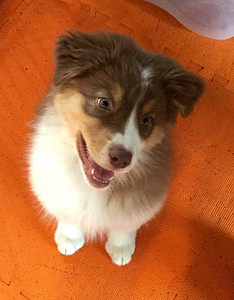
The cue “sit” was only added when we were willing to bet $10 that this puppy would put her bum on the ground immediately after we said it.
What is a cue? A cue is a name or label for a particular behavior. It is the “green light” for the dog that tells it “perform that behavior now to get rewarded”. Once a behavior is on cue, the dog should only offer it upon perceiving the cue.
The most common examples of cues in dog training are words like “sit” or “down,” or hand signals that prompt the same behavior.
What should I choose for my cue?
Cues should be able to be given consistently, perceivable by the animal, distinct from other cues the animal already knows, not confused with praise or other meanings, and easy to transfer to others.
Spoken words and hand signals make popular cues because they meet all of these criteria, and that is what we generally use. However, a cue can be anything your dog is capable of perceiving, which allows you to get creative!
In our Nosework classes, the presence of a particular odor acts as the dog’s cue to indicate to her handler that she has discovered the source.
How do I teach a cue?
To start, make sure the dog is offering the behavior consistently. We do not add a cue to a behavior until the dog knows how to perform it without lures or prompts from you. When you are willing to bet $10 that your dog is going to offer that behavior, it is time to add the cue.
Just before your dog offers the behavior, quietly say the word or make a subtle hand signal. (Make sure you do not have food in the hand you are using to make the hand signal.)
When the dog performs the behavior, click and then treat. If the dog is in a stationary position, like sit or down, then toss an additional cookie a short distance away so the dog gets up. This treat “resets” the dog so you can cue them to sit or down again. As soon as your dog has finished eating, give the cue again.
Continue this sequence of cue-behavior-click-treat several times in a row. After each treat, pause ever so briefly before cuing. If the dog pauses too, immediately give the cue, and click and treat the resulting behavior. If the dog anticipates the cue, do not click or give the dog a treat. Wait several seconds until the dog stops offering the behavior, then give the cue.
If you give the cue and the dog doesn’t offer the behavior, wait several seconds before cueing again. I usually count to 10 in my head before re-cueing the dog. I don’t want to fall into the trap of saying the cue over and over again before my dog complies. “Sit, sit, sit, sit, sit!” should not be your goal!
Next Steps
Click quickly for tentative offers of behavior, and treat generously for initial successes in new situations. Remember not to click this behavior unless you have cued it. Next, it is time to take this behavior on the road and train in new situations and environments. Practice in different rooms of the house, outdoors, with people present, with other dogs in the room, etc. Happy training!
